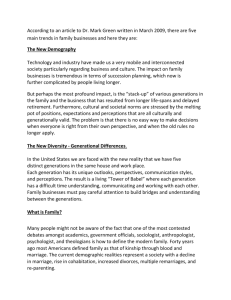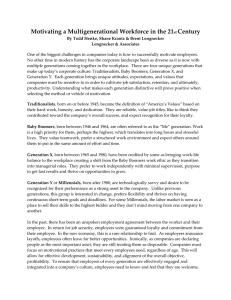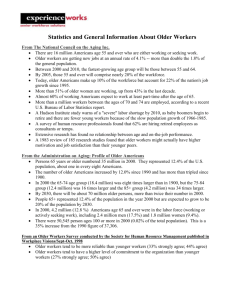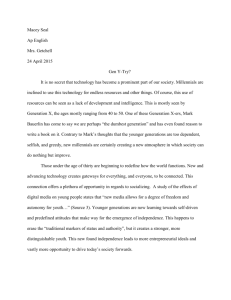Generational Differences in Perceptions of Older Workers’ Capabilities Issue Brief 12
advertisement
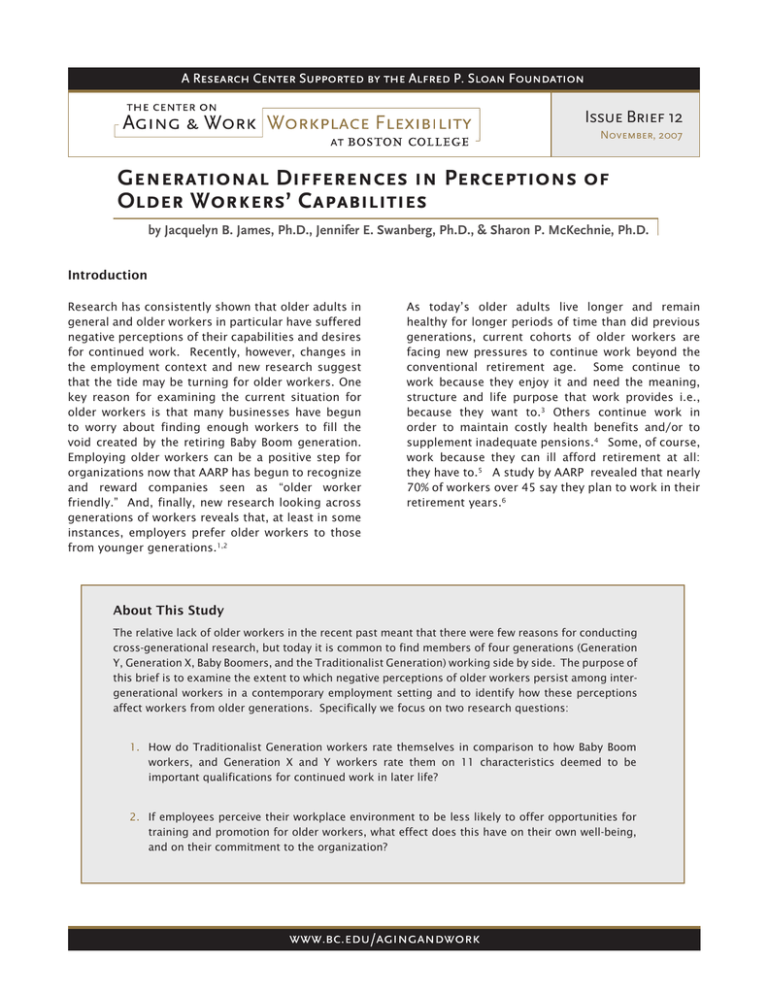
Issue Brief 12 November, 2007 Generational Differences in Perceptions of Older Workers’ Capabilities by Jacquelyn B. James, Ph.D., Jennifer E. Swanberg, Ph.D., & Sharon P. McKechnie, Ph.D. Introduction Research has consistently shown that older adults in general and older workers in particular have suffered negative perceptions of their capabilities and desires for continued work. Recently, however, changes in the employment context and new research suggest that the tide may be turning for older workers. One key reason for examining the current situation for older workers is that many businesses have begun to worry about finding enough workers to fill the void created by the retiring Baby Boom generation. Employing older workers can be a positive step for organizations now that AARP has begun to recognize and reward companies seen as “older worker friendly.” And, finally, new research looking across generations of workers reveals that, at least in some instances, employers prefer older workers to those from younger generations.1,2 As today’s older adults live longer and remain healthy for longer periods of time than did previous generations, current cohorts of older workers are facing new pressures to continue work beyond the conventional retirement age. Some continue to work because they enjoy it and need the meaning, structure and life purpose that work provides i.e., because they want to.3 Others continue work in order to maintain costly health benefits and/or to supplement inadequate pensions.4 Some, of course, work because they can ill afford retirement at all: they have to.5 A study by AARP revealed that nearly 70% of workers over 45 say they plan to work in their retirement years.6 About This Study Issue Brief 12 The relative lack of older workers in the recent past meant that there were few reasons for conducting cross-generational research, but today it is common to find members of four generations (Generation Y, Generation X, Baby Boomers, and the Traditionalist Generation) working side by side. The purpose of this brief is to examine the extent to which negative perceptions of older workers persist among intergenerational workers in a contemporary employment setting and to identify how these perceptions affect workers from older generations. Specifically we focus on two research questions: 1. How do Traditionalist Generation workers rate themselves in comparison to how Baby Boom workers, and Generation X and Y workers rate them on 11 characteristics deemed to be important qualifications for continued work in later life? 2. If employees perceive their workplace environment to be less likely to offer opportunities for training and promotion for older workers, what effect does this have on their own well-being, and on their commitment to the organization? 1 Who is an Older Worker? There is no consensus about who is and who is not an older worker. Pitt-Catsouphes and Smyer suggest that the definition varies across historical periods and industrial sectors, and in some cases, the definition is not as linked to chronological age as it once was.7 As long ago as 1986, Zepelin, Sills, and Heath found that “those between ages 18 and 35 were considered young; those between 35 and 60 were considered middle aged, and those between 65 and 80 were considered old.”8 Gergen and Gergen say that current generations do not expect to think of themselves as “old” until age 80.9 Thus, researchers use different definitions. Anyone over 40 is protected by the Age Discrimination in Employment Act (ADEA). In general a worker starts to be older at age forty for hiring purposes.10 Nearly 40% of employees think that employers begin to view a worker as old by the age of 50.11 Pitt-Catsouphes and Smyer define an older worker as 45+ years and point out that those workers make up 37% of the U.S labor force.12 Twenty years ago, Ashbaugh and Fay reviewed over 100 studies and found that the average age for operationalizing “older workers” was 53.4.13 One recent study examining perceptions of older workers used age 55+ as the definition.2 We have chosen to use that definition for this study, as it was used in our survey questions as the boundary. Younger Generations in the Workplace In the context of the study presented here, younger workers span 2-1/2 generations. (See Figure 1.) On the other hand, members of the older generations of workers are widely seen as disinterested in promotion, yearning for retirement, and decelerating (Simon, 1996).18 Younger generations of workers, especially Generation Y, are seen as eager to get ahead, and impatient for promotions.15,19 Moreover, Siegel (1993) found that younger workers are clearly perceived as having a greater likelihood of promotion.20 With heightened interest in differences among the generations, and little research on different generations’ perceptions of their older co-workers, it is important to explore the extent of these differences. Using our definition of older workers (55+), all members of the Traditionalist Generation are older workers as are older members of the Baby Boom Generation. Research on Perceptions Traditionalists (Born before 1946) Baby Boomers (Born 1946-1964) Older Workers (Over 55) Generation X (Born 1964-1980) Generation Y (Born after 1980) Younger Workers (Under 55) Although different analysts use slightly different eras and descriptors for “generation,” Eisner suggests the following delimiters: Traditionalists (born before We do not have to go far to find negative images of the elder population. Birthday cards are rife with depictions of hair loss, wrinkles, memory deficits, sagging bodies, toothless jaws, and the “over the hill” theme in general. These images also abound in the print and television media.21 Levy and Banaji find that discrimination against older people is more entrenched than any of the other “isms” they study.22 Ageism is particularly pernicious because all of us are aging, no matter how old we are, and if we are 2 Issue Brief 12 Figure 1: Generational Span of Older and Younger Workers 1946), Baby Boom (1946-1964); Generation X (1965-1980); and Generation Y, born since 1980.14 It is said that these generations have different values, attitudes and expectations based upon formative events in their lives, although there are individual differences in the response to the same event.15 Stillman says that the mix of ages and stages in the 21st century workplace creates a kind of collision course and creates challenges for management.16 Much of what we know about inter-generational differences, however, is derived from the popular press and proprietary studies within organizations, although some academic research has begun. It is important to add that there is also controversy about whether age, generation, career stage or the life course perspective is the more useful lens through which to view differences among the vast array of workers in the workplace today.17 lucky, we will all be elders. As Duncan and Loretto point out, everyone is prone to age discrimination; thus, “…it is difficult to distinguish oppressor from oppressed” (p. 97).23 Older people themselves often have negative views of elders. Indeed negative views of older persons may be viewed as legitimate by government rules, customs, social norms, and physical conditions.24 Such views extend to the workplace and can have damaging effects on the careers and psychological health of older workers.25 Recent research on perceptions of older workers has identified both negative and positive stereotypes in employer attitudes toward older employees.23 On the positive side, older workers are seen as having a good work ethic, and a good attitude toward work. On the negative side, they are considered to be stuck in their ways, and, as mentioned, not interested in further training or promotions. Rix , for example, describing periodic surveys with employers over 15 years, reports that they “consistently tend to rate older workers highly when it comes to loyalty, dependability, experience, and customer relations; however they rate older workers far less positively when it comes to flexibility, adaptability, technological competence, and ability to learn new technology” (p. 35).26 Older workers are also seen as incurring higher costs for the organization1 and as unhealthy or in decline.25 Negative perceptions have been particularly pronounced in the area of training, where managers and other employees as well see older workers as slow learners, computer illiterate, as disinterested in training, and hankering for retirement.18 Unfortunately, if negative perceptions persist about older workers’ ability to learn, their propensity for career development and promotion, and their general adaptive capacities, then older workers will continue to face obstacles to continued employment.1 We assessed employees’ perceptions of older workers using 11 items from Marshall’s Issues of an Aging Workforce Study.27 Participants were asked to indicate the extent to which they agreed or disagreed (1=strongly disagree; 2=disagree; 3=neutral; 4=agree; 5=strongly agree) with the following statements: Workers 55 and older… ρρ …can serve as mentors to younger workers. ρρ …are respected. ρρ …are more reliable than younger workers. ρρ …adapt well to new technology. ρρ …are eager for training. ρρ …work well with younger supervisors. ρρ …are just as likely to be promoted as younger workers. ρρ …have great loyalty to the company. ρρ …are flexible. ρρ …are interested in being promoted. We assessed the employees’ general perception of opportunity for advancement in the organization by asking them to state the extent to which they agreed or disagreed (same scale as above) with the statement: “In decisions about promotion, CitiSales gives younger people preference over older people.” We also assessed employee engagement using the organization’s own measure. Again, employees were asked the extent to which they agreed or disagreed (same scale as above) with the following questions: Issue Brief 12 ρρ I feel like I am an important part of CitiSales. ρρ I really care about the future of CitiSales. The Current Study How pervasive are such perceptions today? How damaging are they? To whom? The worker, the employer, or both? Using data gathered as part of a larger study comprising employees in 388 stores and 37 districts of a national, retail chain (hereafter referred to as CitiSales, a pseudonym) we examine the perceptions of older workers across four generations, while also studying the effects of these perceptions on the older workers themselves. ρρ I feel like my work makes an important contribution to CitiSales’ success. ρρ I would highly recommend CitiSales to a friend seeking employment. ρρ I am always willing to give extra effort to help CitiSales succeed. ρρ It would take a lot to get me to leave CitiSales. ρρ I would like to be working for CitiSales one year from now. ρρ Compared with other companies I know about, I think CitiSales is a great place to work. 3 Results with age. In each of the following perceptions of capabilities, the responses are significantly more negative with each successive generation, from Traditionalists to Generation Y: the ability of older workers to serve as mentors; seeing older workers as reliable; deeming them to be more productive than younger workers; seeing them as adaptable to new technology; eager for training; and flexible. (See Figure 2.) Research Question 1: In general, how do different generations rate older workers on 11 characteristics deemed to be important qualifications for continued work in later life? Are there any differences in perceptions of older workers related to respondent’s employment status, gender, marital status, race, or education level? The responses for six of the eleven categories varied Figure 2:Perceptions of Older Workers Extent of Agreement 5 Workers 55 and over are... 4 3 2 1 0 Good Mentors More Reliable Traditionalists More Adaptable Productive Baby Boomers Further, the older generations are more positive in their responses regarding older employees’ ability to work well with younger supervisors and to be loyal to the company. (See Figure 3.) Employees from the Traditionalists Generation agree with these statements Eager for Training Generation X Flexible Generation Y significantly more than do the other three generations. In turn, the Baby Boom Generation agrees with these same statements significantly more than those in Generation X and Y, with no significant differences between the responses of the younger two groups. Figure 3:Perceptions of Older Workers Extent of Agreement Issue Brief 12 5 Workers 55 and over... 4 Traditionalists Baby Boomers Generation X 3 2 Generation Y 1 0 Work Well with Younger Supervisors Are Loyal 4 In a shift from the positive correlation of age with positive perceptions of capabilities, the Baby Boom Generation agrees significantly less than do the other three groups that older workers are “respected,” with no significant differences among the responses of the other three groups. (See Figure 4.) Those from Generation X agree significantly less than those from the other three groups that older workers are interested in being promoted. Again in this instance, the responses from the other three generations are not significantly different. It is interesting to note here that the youngest generation in this work environment agrees that older workers are interested in promotion opportunities to the same extent that the older workers themselves do. Finally, in terms of perceiving that older workers are “just as likely to be promoted” as younger workers, the two older generations’ responses did not differ significantly, however both the Traditionalists Generation and the Baby Boom Generation agree with this statement significantly less than those from generations X and Y do. Figure 4:Perceptions of Older Workers Extent of Agreement 5 Workers 55 and over are... 4 3 Traditionalists Baby Boomers Generation X 2 Generation Y 1 0 Respected Interested in Promotion opportunities for older workers are all significantly higher in employee engagement than those who do not. However, the youngest group of employees, those from generation Y, report significantly lower levels of employee engagement when they perceived workers over 55 had the same opportunities for promotion as younger workers. We will return to this point. In terms of psychological well-being, employees among the two older generations who perceive equal opportunities for older workers are significantly higher in well-being than those who perceive an unfair advantage for younger workers. (See Figure 6.) 5 Issue Brief 12 Research Question 2: If employees perceive that there are fewer opportunities for promotion for older workers, what effect does this have on well-being and employee engagement? To examine the effects of perceptions of age discrimination for each of the generations, the responses for each group were analyzed individually. In each case the responses were split into: (1) those who disagreed that younger workers are more likely to get promoted; (2) those who agreed that younger workers are more likely to get promoted (the responses of those who reported a neutral stance on this statement were not included in this analysis). The results show that there are significant differences among all of the groups. (See Figure 5.) Employees from the three older generations who perceive equal promotion Likely to be Promoted Figure 5:Effects of Negative Perceptions of Opportunities for Older Workers Employee Engagement 40 35 30 Perceive: 25 Opportunity for Promotion No Opportunity for Promotion 20 15 10 5 0 Traditionalists Baby Generation Generation Boomers X Y Figure 6:Effects of Negative Perceptions of Opportunities for Older Workers 10 Wellbeing 8 Perceive: 6 Opportunity for Promotion No Opportunity for Promotion 4 2 0 Traditionalists Baby Generation Generation Boomers X Y Issue Brief 12 6 Conclusion: Summary and Implications ρρ In general, older workers (both the Traditionalists Generation and the Baby Boom Generation) are very positive about themselves and the company they work for. They see themselves as more reliable than younger workers, more productive, and as having great loyalty to the company. Indeed they have the highest employee engagement scores. ρρ On the other hand, older workers are more likely to perceive that younger workers are given preference in training and development opportunities. For those in the 3 older generations who have this perception, employee engagement and psychological well-being is lower than for those who do not hold this view. Interestingly, members of Generation Y who hold this perception are more engaged than those who do not. This suggests, as some have reported, that Generation Y is subjected to the opposite type of stereotyping i.e., often reminded that they are too young for a promotion. Unlike Generation X, Generation Y was more likely to believe that older workers were interested in promotions. They may have been expressing their feeling that less opportunity for older workers means more opportunity for them. Such findings suggest that the lens of “generation” is a useful one here for understanding some level of conflict that may exist among workers of the oldest and the youngest generations in today’s workplace. ρρ Important caveat—Hagen says that “with a few exceptions it is impossible to generalize about older employees—their individual differences are at least as great as those of any other age group…they include the wise and the foolish, the bitter and the cheerful, the dedicated and the clock-watchers, the slipshod and the careful workers” (p. 7).28 We believe this statement holds for each generation. In our study there are men, women, professional workers, hourly workers, people of different races and ethnicity, and those who are more and less educated. These are but a few of the within-generation differences that matter in thinking about people’s values, attitudes, and work styles. ρρ Managers have a complex balancing act to meet the expectations and needs of a multi-generational workforce. Many employees in the older generations still want and need training, development, and recognition for their work in terms of promotion. However, employees from the youngest generation can become discouraged if they see all the opportunities and promotions going to workers from the older generations. Determining which staff will be developed and promoted will have to be based on some transparent standard not related to age or generation. This issue is one that managers will need to handle carefully to ensure retention and engagement from employees of all generations. The Center’s multi-disciplinary core research team is comprised of more than 20 social scientists from disciplines including economics, social work, psychology, and sociology. The investigators have strong expertise in the field of aging research. In addition, the Center has a workplace advisory group (SENIOR Advisors) to ensure that the priorities and perspectives of business leaders frame the Center’s activities and a Research Advisory Committee that provides advice and consultation on the Center’s individual research projects and strategic direction. The Center is directed by Marcie Pitt-Catsouphes, Ph.D., and Michael A. Smyer, Ph.D. Jacquelyn B. James, Ph.D., is a research associate at the Center on Aging and Work/Workplace Flexibility, a research director at the Boston College Center for Work & Family, and a research professor at the Lynch School of Education, also at Boston College. She 7 Issue Brief 12 The Center on Aging & Work/Workplace Flexibility at Boston College, funded by the Alfred P. Sloan Foundation, is a unique research center established in 2005. The Center works in partnership with decision-makers at the workplace to design and implement rigorous investigations that will help the American business community prepare for the opportunities and challenges associated with the aging workforce. The Center focuses on flexible work options because these are a particularly important element of innovative employer responses to the aging workforce. The studies conducted by the Center are examining employers’ adoption of a range of flexible work options, the implementation of them at the workplace, their use by older workers, and their impact on business and older workers. received her Ph.D. in personality and developmental psychology at Boston University. Her research has focused on the meaning and experience of work in women’s lives, gender roles, and adult development. She and her colleagues have published numerous articles, opinion pieces, and four edited books. The most recent volume (with co-author Dr. Paul Wink, professor of psychology at Wellesley College), The Crown of Life: Dynamics of the Early Postretirement Period, is about the opportunities and challenges inherent in the early retirement years for new generations of retirees. She is also co-principal investigator of the Workplace Culture and Flexible Work Arrangements study funded by Center on Aging and Work/Workplace Flexibility. Dr. James is past-president of the Society for the Study of Human Development and serves on the editorial board of the society’s flagship journal, Research in Human Development. Sharon P. McKechnie, Ph.D., is an Assistant Professor in the Management and Economics Department of Emmanuel College, Boston. She received her Ph.D. in management with a concentration in organization studies from Boston College, an M.Sc. in organizational psychology from UMIST, and a B.Sc. from Napier University. She is currently a senior research associate at the Center for Work and Family at Boston College and was a research assistant in 2006 at the Center for Aging and Work/Workplace Flexibility at Boston College. Jennifer E. Swanberg, Ph.D., is executive director of the Institute for Workplace Innovation at the University of Kentucky, and associate professor in the UK College of Social Work with joint appointments in the Colleges of Medicine and Public Health. She is also a faculty affiliate with the UK Center on Poverty Research and the Center for the Advancement of Women’s Health, a research investigator at the Boston College Center on Aging and Work/Workplace Flexibility and a Research Fellow of the Boston College Work & Family Roundtable. Her research focuses on quality workplaces as a business and work-life effectiveness strategy, access to workplace flexibility among under-represented populations, and the use of human capital and quality employment as a form of economic development. She is co-principal investigator of the Workplace Culture and Flexible Work Arrangements study funded by Center on Aging and Work/Workplace Flexibility. Dr. Swanberg has published widely in research journals and has appeared as a national work-life expert on television and radio. Dr. Swanberg was a recipient of the Alliance of Work-Life Progress Rising Star Award, and in 2005 her research was selected as one of the top 10 research articles by the Rosabeth Moss Kanter Award for Excellence in Work-Family Research. Marcie Pitt-Catsouphes, Ph.D., is an Associate Professor at the Boston College Graduate School of Social Work. She received her B.A. from Tufts University, M.S.P. from Boston College, and Ph.D. from Boston University. She is the CoPrincipal Investigator of the Boston College National Study of Business Strategy and Workforce Development and Age and Generations Study. She is the founder of the Sloan Work and Family Research Network, which provides resources about working families to business leaders and state legislators, as well as to academics around the world. Dr. Pitt-Catsouphes was a 2007 recipient of the Work/Life Legacy Award. Michael A. Smyer, Ph.D., is a Professor in the Department of Psychology at Boston College. A licensed clinical psychologist, he received his Ph.D. in personality and clinical psychology from Duke University and a B.A. in psychology from Yale University. Dr. Smyer was awarded the M. Powell Lawton Award for distinguished contributions to clinical geropsychology, sponsored by the American Psychological Association and the Retirement Research Foundation. He is the Co-Principal Investigator of the Boston College National Study of Business Strategy and Workforce Development and Age and Generations Study. 1 Pitt-Catsouphes, M., Smyer, M. A., Matz-Costa, C., & Kane, K. (2007). The national study report: Phase II of the national study of business strategy and workforce development (Research Highlight No. 04). Chestnut Hill, MA: The Center on Aging & Work/Workplace Flexibility. Retrieved August 22, 2007 from http://agingandwork.bc.edu/documents/RH04_NationalStudy_03-07_004.pdf 2 Munnell, A. H., Sass, S., & Soto, M. (2006). Employer attitudes towards older workers: Survey results. Chestnut Hill, MA: Center for Retirement Research at Boston College. Retrieved November 26, 2007 from http://www.bc.edu/centers/crr/issues/wob_3.pdf 3 Smyer, M. A., & Pitt-Catsouphes, M. (2007). The meanings of work for older workers. Generations, 31(1), 23-30 4 Munnell, A. H., & Sunden, A. E. (2004). Coming up short: The challenge of 401(k) plans. Washington, D.C.: Brookings Institution. 5 Sorenson, A. (2007). The demography of the third age. In J. B. James, & P. Wink (Eds.), The crown of life: Dynamics of the early postretirement period (pp. 1-18). New York: Springer. 6 Brown, S. K. (2003). Staying ahead of the curve 2003: The AARP working in retirement study. Washington, D.C.: AARP Knowledge Management. Retrieved November 26, 2007 from http://assets.aarp.org/rgcenter/econ/multiwork_2003.pdf 7 Pitt-Catsouphes, M., & Smyer, M. A. (2006). How old are today’s older workers? (Issue Brief No. 04). Chestnut Hill, MA: The Center on Aging and Work/ Workplace Flexibility at Boston College. Retrieved November 26, 2007 from http://agingandwork.bc.edu/documents/IB04_HowOldAreWrkrs.pdf 8 Nelson, T. D. (2002). Ageism: Stereotyping and prejudice against older persons. Cambridge, Mass.: MIT Press. 8 Issue Brief 12 References: 9 Gergen, K., & Gergen, M. (2003). Positive aging: Sustaining the vision. Positive Aging Newsletter(18). Retrieved November 26, 2007 from http://www.taosinstitute.net/resources/pa/?m=200301&cat=4 10 Lahey, J. (2005). Age, women, and hiring: An experimental study (NBER Working Paper No. 11435). Washington, D.C.: National Bureau of Economic Research. 11 Reynolds, S., Ridley, N., & Van Horn, C. (2005). A work-filled retirement: Workers’ changing views on employment and leisure (Work Trends Survey No. 8.1). New Brunswick, NJ: John J. Heldrich Center for Workforce Development, Rutgers University. Retrieved October 30, 2007 from http://www.heldrich.rutgers.edu/uploadedFiles/Publications/WT16.pdf 12 Pitt-Catsouphes, M., & Smyer, M. A. (2005). Businesses: How are they preparing for the aging workforce? (Issue Brief No. 02). Chestnut Hill, MA: Boston College Center on Aging & Work/Workplace Flexibility. Retrieved November 26, 2007 from http://agingandwork.bc.edu/documents/ IB02_BusinessPreparing.pdf 13 Ashbaugh, D. L., & Fay, C. H. (1987). The threshold for aging in the workplace. Research on Aging, 9(4), 417-427. 14 Eisner, S. P. (2005). Managing generation Y. SAM Advanced Management Journal, 70(4), 4-15. 15 Stewart, A. J., & Healy, J. M. (1989). Linking individual development and social changes. American Psychologist, 44(1), 30-42. 16 Lancaster, L. C., & Stillman, D. (2005). When generations collide : Who they are, why they clash, how to solve the generational puzzle at work (1st ed.). New York: Collins Business. 17 Pitt-Catsouphes, M., & Smyer, M. A. (2007). The 21st century multi-generational workplace (Issue Brief No. 09). Chestnut Hill, MA: Boston College Center on Aging & Work/Workplace Flexibility. Retrieved November 1, 2007 from http://agingandwork.bc.edu/documents/IB09_ MultiGenWorkplace_001.pdf 18 Simon, R. (1996). Too damn old. Money, 25(7), 118. 19 Smola, K. W., & Sutton, C. D. (2002). Generational differences: Revisiting generational work values for the new millennium. Journal of Organizational Behavior, 23(4), 363. 20 Siegel, S. R. (1993). Relationships between current performance and likelihood of promotion for old versus young workers. Human Resource Development Quarterly, 4(1), 39-50. 21 Friedan, B. (1993). The fountain of age. New York: Simon & Schuster. 22 Levy, B. R., & Banaji, M. R. (2004). Implicit ageism. In T. D. Nelson (Ed.), Ageism: Stereotyping and prejudice against older persons (pp. 49-75). Cambridge, MA: MIT Press. 23 Duncan, C., & Loretto, W. (2004). Never the right age? Gender and age-based discrimination in employment. Gender, Work & Organization, 11(1), 95-115. 24 Parry, E. L., & Tyson, S. (2006). Organisations’ strategies for approaching age discrimination at work. Paper presented at the Annual Conference of the British Academy of Management (Human Resources Division), London. Unpublished manuscript. 25 McCann, R., & Giles, H. (2004). Ageism in the workplace: A communication perspective. In T. D. Nelson (Ed.), Ageism: Stereotyping and prejudice against older persons (pp. 163-199). Cambridge, MA: MIT Press. 26 Rix, S. E. (2001). Toward active ageing in the 21st century: Working longer in the United States. Notes from the Symposium of the Japanese Institute of Labor, Tokyo, Japan. Unpublished manuscript. 27 Marshall, V. W. (2006). Issues of an aging workforce in a changing society: Cases and comparisons (final report of project). Toronto: University of Toronto, Centre for Studies of Aging. 28 Hagen, R. P. (1983). Older workers: How to utilize this valuable resource. Supervisory Management, 28, 2-9. Issue Brief 12 This work was supported by the Sloan Center on Aging and Work: Workplace Flexibility at Boston College (Sloan grant #5000719), by the Ford Foundation (#1050-0632), and by the organization where the work took place (CitiSales, a pseudonym). We are grateful to the leadership of CitiSales for its willingness to support research within its organization, and to the many employees (hourly and professional workers, district managers, and regional managers) who graciously shared their time and experiences with us. We are also grateful to Dale Mahoney and Caroline Macke for their skillful interviewing techniques, and to Mac Werner for data preparation and management. 9 For previous publications, visit our website at www.bc.edu/agingandwork Issue Briefs Issue Brief 1: Older Workers: What Keeps Them Working? Issue Brief 2: Businesses: How Are They Preparing For the Aging Workforce? Issue Brief 3: Getting the Right Fit: Flexible Work Options and Older Workers Issue Brief 4: How Old Are Today’s Older Workers? Issue Brief 5: One Size Doesn’t Fit All: Workplace Flexibility Issue Brief 6: Down Shifting: The Role Of Bridge Jobs After Career Employment Issue Brief 7: Civic Engagement: Volunteering Dynamics and Flexible Work Options Issue Brief 8: Does Health Insurance Affect The Employment of Older Workers? Issue Brief 9: The 21st Century Multi-Generational Workplace Issue Brief 10: Today’s Multi-Generational Workforce: A Proposition of Value Issue Brief 11: Responsive Workplaces for Older Workers: Job Quality, Flexibility and Employee Engagement Research Highlights Research Highlight 1: Context Matters: Insights About Older Workers From the National Study of the Changing Workforce Research Highlight 2: The Diverse Employment Experiences of Older Men and Women in the Workforce Research Highlight 3: The Benchmark Study, Phase I of The National Study of Business Strategy and Workforce Development Research Highlight 4: The National Study, Phase II of The National Study of Business Strategy and Workforce Development Issue Brief 12 10
